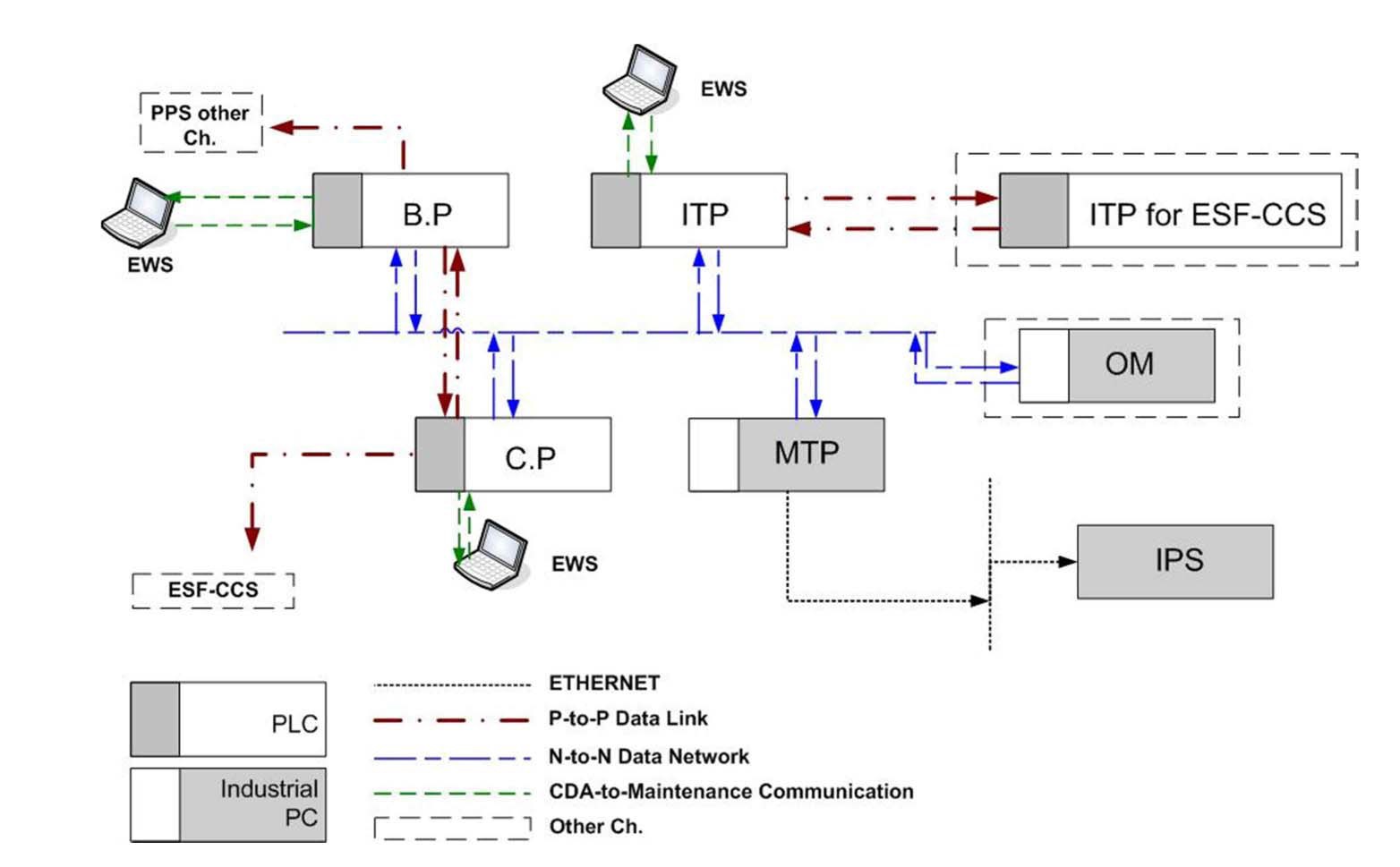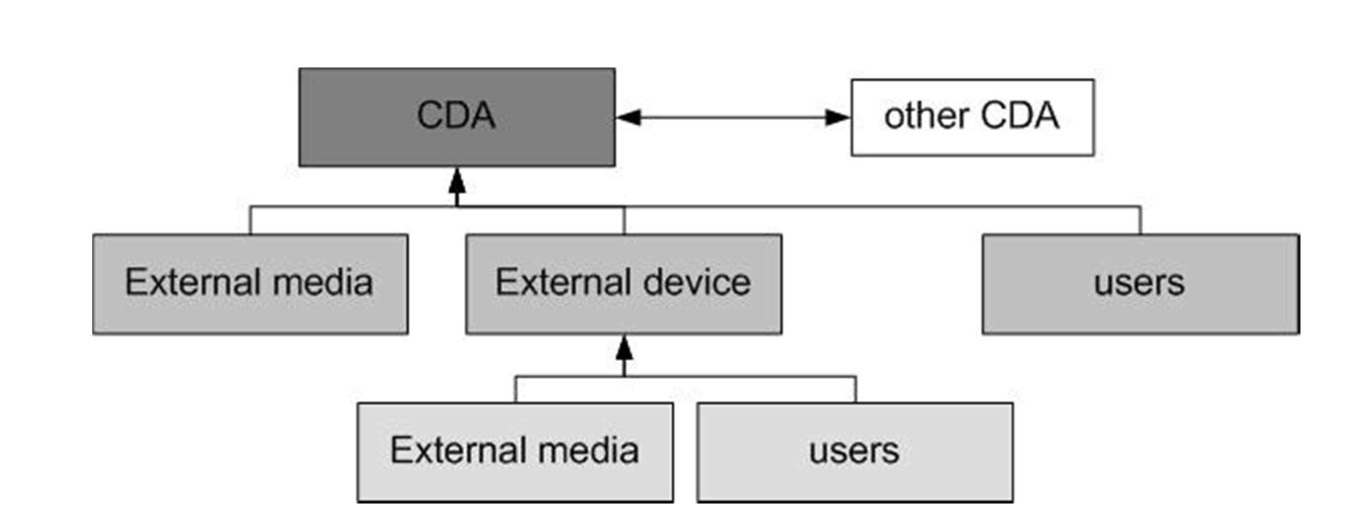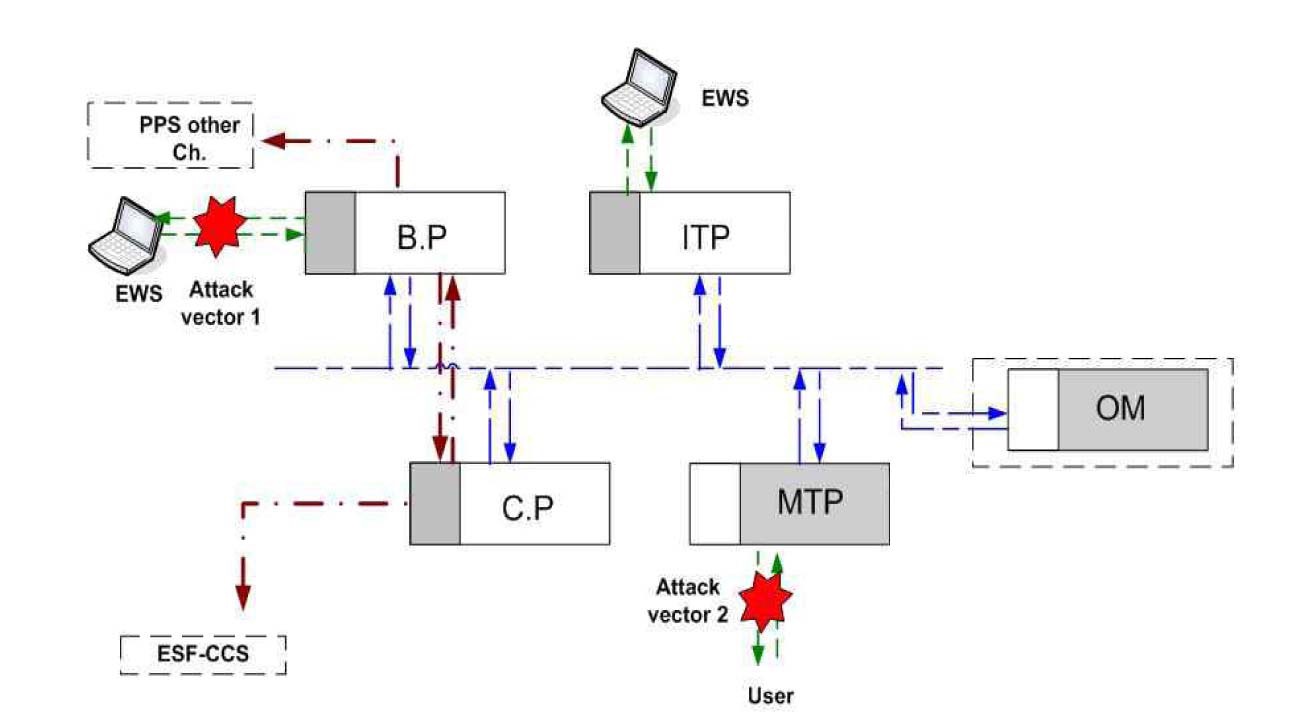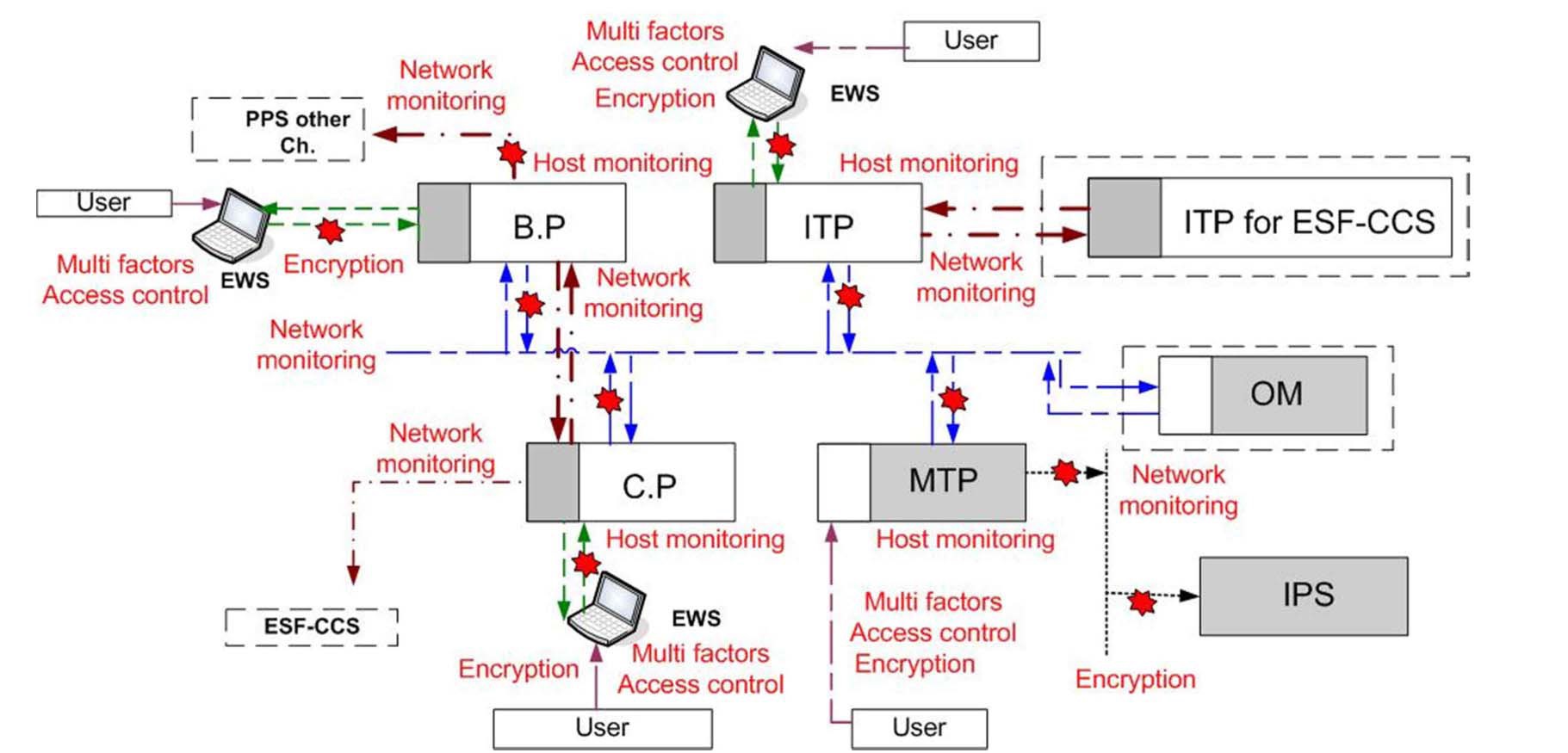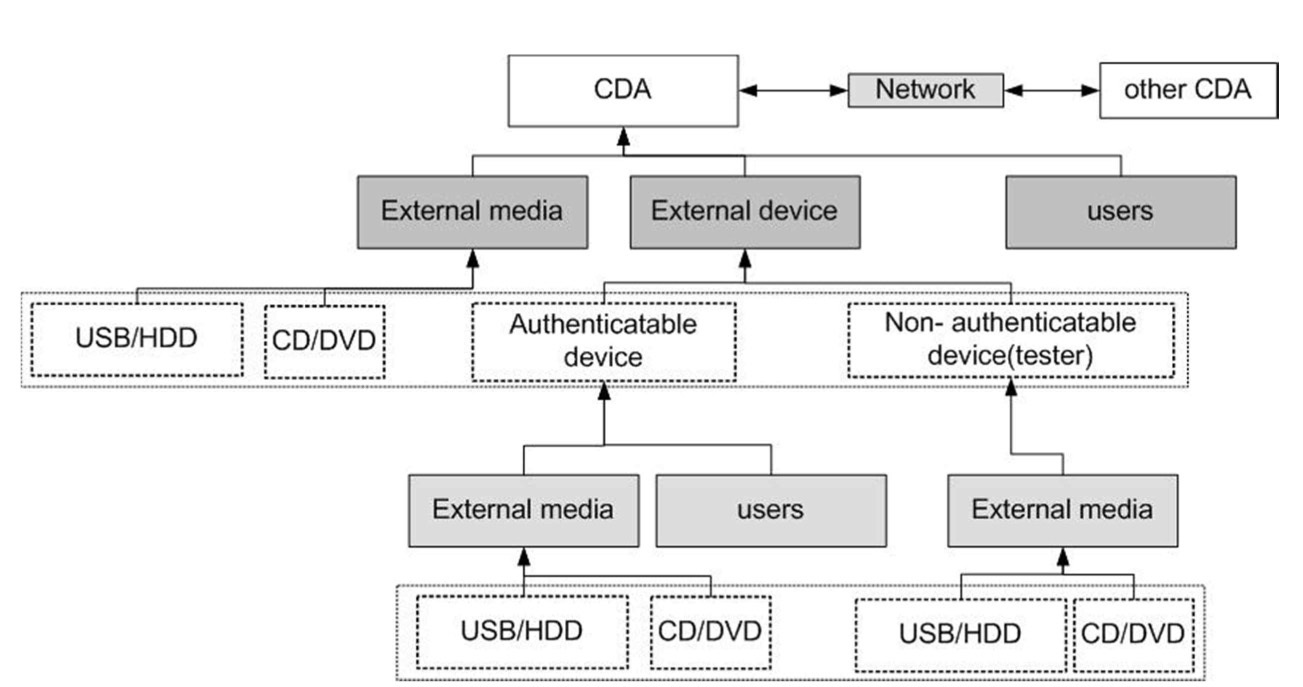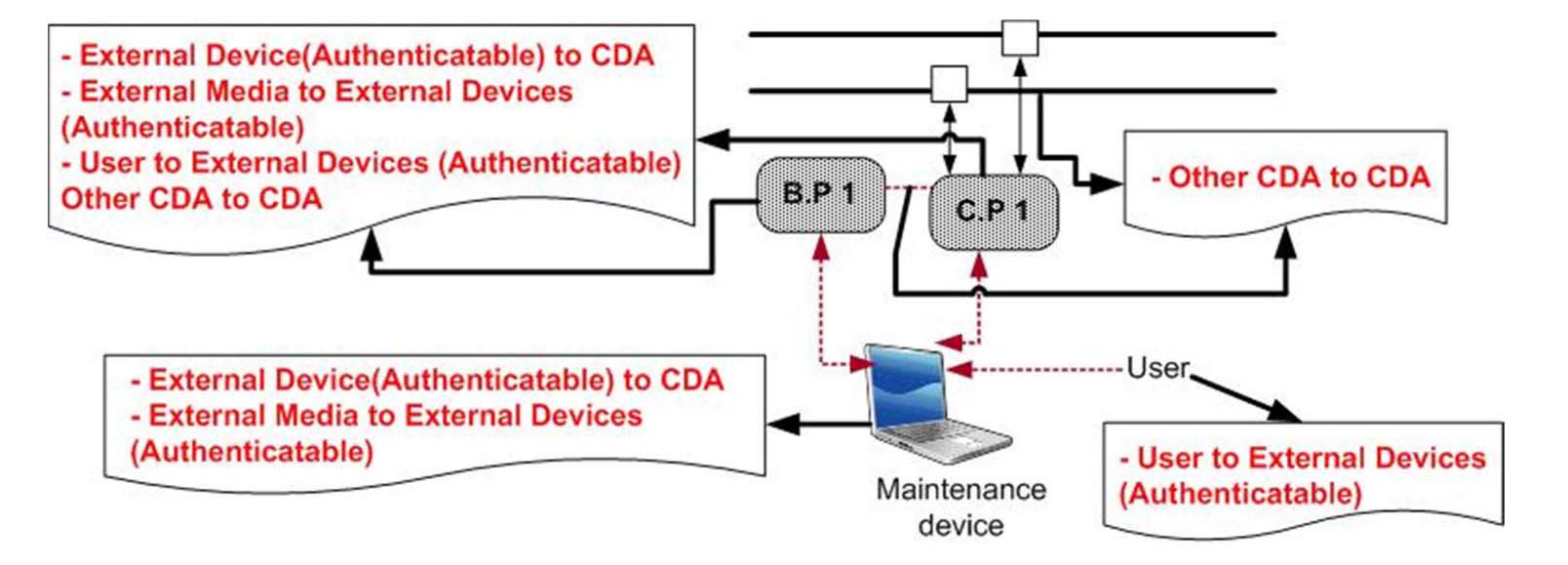



Instrumentation and control (I&C) systems, which are important for the safety and performance of nuclear power plants (NPPs), have been digitalized for the purpose of the maintenance and precise operation of plants[1]. This digitalization, however, brings out issues related to cyber security. In particular, the cases of damage to national critical infrastructures, including nuclear facilities, owing to cyber attacks that passed over air gaps between the facility and the outside, have raised immediate needs for cyber security measures. As a response to this, many nuclear industries have isolated their I&C systems from the networks connected to the internet.
For the cyber security of NPP I&C systems, many regulatory requirement documents[2,3,4], the IAEA guide NSS-17[5], the IEEE Standard 7-4.3.2 [6] were already published, while the IEC standards are undergoing a preparatory phase. There are many documents addressing cyber security of industrial control systems (ICSs) as well as supervisory control and data acquisition (SCADA) systems [7~13]. Many of these documents focus on network security, since these systems commonly have connections with corporate business networks. In the cyber security domain, NPP I&C systems tend to be addressed from the viewpoint of ICS and SCADA systems. NPP I&C systems, however, have characteristics different from ICS and SCADA systems [14~16]., Safety regulations for NPP I&C systems require limitations in data communications between safety systems and non-safety systems, defensein- depth and diversity, and rigorous hardware and software qualification including verification and validation, safety analysis, and configuration management. These safety regulation requirements already address some requirements for cyber security. Hence, NPP I&C system designers may encounter difficulties when trying to satisfy the newly issued cyber security requirements, while identifying additional design features and where and how to apply those to their systems.
Methods for cyber security risk and vulnerability assessments, have been studied recently by international standard organizations, regualtory institutes, and research institutes. Among these, the National Institute of Standards and Technology (NIST) risk assessment method, proposed in NIST 800-82[9], NIST 800-53[17] and NIST 800-30[18], can be considered as a representative case. Overall system characteristics including cyber threat cases are analyzed, and the possibility of malicious behaviour exploiting system vulnerabilities is then evaluated in this method. Based on assessments of availability, integrity, and confidentiality, especially through likelihood determination and impact analyses, risks owing to system vulnerabilities are rated at three levels of severity. For the IT systems, confidentiality and integrity are addressed more importantly than availability in risk assessments. When applying this method to the I&C systems in NPPs, the quantification or rating of risks may be inappropriate and hard to validate, since how and to what extent risks affect the system safety and availability cannot be assessed simply as in the IT systems.
The U.S. NRC published the Regulatory Guide 5.71 (RG 5.71)[3] for the cyber security of new and operating NPPs, and the IAEA issued NSS-17[5] as a technical guidance for computer security at nuclear facilities. These documents provide general approaches and guidance for the cyber security of I&C systems, including cyber security plans and programs, methods for cyber security assessments, and a comprehensive set of security controls. However, there are still difficulties from the system designer’s point of view when it comes to decision making about which technical controls to which parts of the target I&C systems need to be applied. Practical examples for the application of technical security controls have not been available to the system designers, leading to difficulties when defining appropriate security control requirements and security design features for the individual I&C systems.
In a previous study [19], a cyber security risk assessment method for the design and development of I&C systems in NPPs was proposed. The method describes an assessment process specified in detail for NPP I&C systems, which consists of a series of steps, including system identification, security modeling, analysis of effects on critical digital assets (CDAs), threat analysis, vunlerability analysis, security control design, and penetration tests. Through this process, potential system vulnerabilities and protection measures can be identified. This approach, based on the basic understanding of NPP I&C systems, presents a way to define cyber security measures that are appropriate for a target I&C system.
This paper follows the assessment process introduced in the previous study, and addresses further studies related to an analysis of vulnerability and to the methods for the selecttion and application of the cyber security requirements and technical security controls presented in RG 5.71. In order to provide information helpful for system designers in the application of cyber security requirements to their systems, this paper describes methods and considerations to define attack vectors in a target system, to review and select the requirements in the RG 5.71, and to integrate the results to identify applicable technical security controls.
The RG 5.71 provides the most complete set of requirements for NPP I&C system designers to identify security design features and apply them to their I&C systems. RG 5.71 addresses various cyber security assessment activities and presents a series of requirements for security controls. To determine which control requirements are applied to which part of the system, the system designers should analyze the systems and perform cyber security assessment activities in accordance with the guidance in RG 5.71. However, example cases of these activities, from which they can obtain information on how to conduct the activities, are not yet available publicly. In this study, to provide detailed guidance helpful to system designers, analyses on attack vectors were performed, and cyber security requirements applicable to specific CDAs in I&C systems were identified.
2.1 Analysis of Attack Vectors
“An attack vector is a path or means by which a hacker can gain access to a computer or network server in order to deliver a payload or malicious outcome. Attack vectors enable hackers to exploit system vulnerabilities, including the human element[20].” Attack vectors on an I&C system may include attack entry points for code injection or other cyber attacks, such as CDAs, networks, and portable devices or media that can be attached to CDAs, as well as their vulnerabilities. Attack vectors can be identified through analyses of system architecture, properties of CDAs, and possible cyber threats to the system, together with penetration tests. As the first step to narrow down the applicable cyber security requirements, the following activities are performed in this study:
1) Analysis of an I&C system architecture at the highest conceptual level;
2) Modeling of a target system from a cyber security point of view;
3) Security level assignments to the CDAs of a target system;
4)Analysis of the elements of attack vectors based on the cyber security model of the system;
5) Investigation of the known vulnerabilties residing in the CDAs and penetration tests to identify potential malicious activities.
2.1.1 Analysis of an I&C System Architecture
ICSs are connected in general to off-site corporate business systems or the Internet. For the cyber security of network connections bewteen the ICS and the outer systems, many NIST documents, including NIST SP800-82 and NIST SP 800-53, describe the measures to be applied. In Korean NPPs, I&C systems have been isolated from the outside after the Stuxnet incident. This study was performed based on an assumption that the I&C systems already maintain air gaps.
At the highest conceptual level, NPP I&C systems can be categorized by safety systems and non-safety systems as shown in Fig. 1. Fig. 1 also illustrates the network connections between the two systems. Safety systems can transmit data to non-safety systems, but a data transmission in the reverse direction is not allowed by nuclear safety regulations and requirements. Defense-in-depth requirements in RG 5.71 specify very similar conditions in which data transmission from CDAs at lower security levels to those at higher security levels are not recommended. These security requirements can be met naturally by assigning security levels to CDAs in accordance with their safety classes.
Because of the isolated network architecture, it is hard to compromise CDAs of I&C systems from the outside by the use of active cyber attack methods. During NPP maintenance and test activities, however, external digital devices or media can be connected to the CDAs and may provide a path to passive cyber attacks such as advanced persistent threats (APTs). For this reason, digital devices for maintenance, calibration, and tests of I&C systems, should be included in the scope of cyber security assessments during the operation phase of plants.
2.1.2 Security Modeling of Target Systems
Security modeling is a way to simplify the functions, roles, service types, and data communications of target systems for an effective security requirement analysis. In this modeling, as noted in our previous paper [19], any system configuration for redundancy may be simplified as a single train. Signal lines from sensors, analog input/output, digital input/output, and one-to-one direct data communication can be excluded or simplified. All kinds of CDAs and data transfer directions and mechanisms within the target systems, should be identified and included in the model. After the analysis of security requirements and technical security controls with this security model, the resultant security controls can be applied to the original systems at the locations corresponding to those in the model.
In this study, a plant protection system (PPS) was selected as an example target system. The PPS, based on programmable logic controllers (PLCs), has four channels. For a security model of this system, the four channels were simplified into one channel and analog lines are excluded as shown in Fig. 2. In Fig. 2, the bistable processor (BP), coincidence processor (CP), and interface and test processor (ITP) are safety-grade PLCs, and the maintenance and test panel (MTP) is an industrial PC. The information processing system (IPS) is a server computer system, and the operator module (OM) is a safety-grade industrial PC installed in the main control room.
The BP transfers signals to the PLCs of other PPS channels, and similarly, the CP does so to the PLCs of another safety system (ESF-CCS: Engineered Safety Features- Component Control System). This communication in BP and CP is one-directional. For data transmission within the same channel, N-to-N type intra-channel network communications are used. Also, the BP and CP transfer information to each other directly through a P-to-P type safety data link. The MTP collects some information from the PLCs through the intra-channel network, then transfers these to the IPS through a one-directional Ethernet network and to the OM through the intra-channel network. For the maintenance and tests of PLCs, a laptop computer (EWS: Enginnering Work Station) may be connected to each PLC.
Table 1 lists data transmission networks and their types used in the PPS.
2.1.3 Security Level Assignments
Security level assignments are needed to apply a defense-in-depth strategy to a cyber security design of I&C systems to effectively protect CDAs from cyber attacks. The NIST SP 800-53[17] and IAEA technical guidance[5]
[Table 1.] Network Types used for the PPS
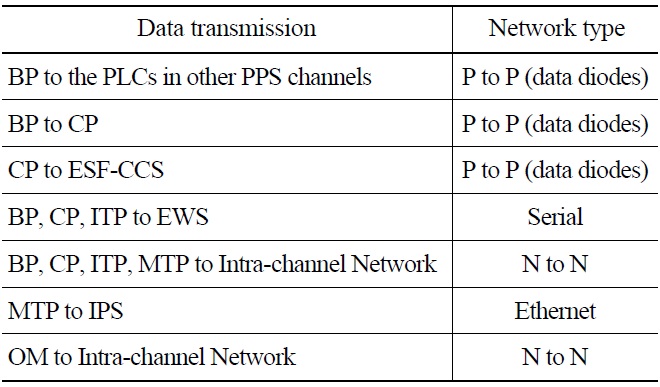
Network Types used for the PPS
recommend a graded approach in which security controls in several grades are applied to CDAs according to their assigned security levels. In contrast, in the NEI 04-04 Revision 1 [21] and RG 5.71 [3], security levels in the defensein- depth strategy define only the limitations of data transmission, but differentiation of the grades of security controls is not addressed. These two documents state that CDAs for safety, important-to-safety, security, or control functions are assigned to security level 4, and CDAs for data acquisition functions to security level 3. In agreement with this, CDAs or systems related to plant safety or plant shutdown are assigned to security level 4 as shown in Fig. 3 in this study. CDAs or systems not related to plant shutdown, but connected to CDAs at level 4 through networks, are allocated to security level 3. Most NPP I&C systems are allocated to either security level 4 or security level 3.
Based on this argument, for the sample PPS, the security levels of the CDAs in Fig. 2 are assigned as in Table 2.
2.1.4. Analysis of the Elements of Attack Vectors
This analysis identified CDAs, which can be infected by malware from outside of the system, or at which any malicious activities can occur. It then estimates how the infection or the activities become possible. It is important in this analysis that all digital equipment and media for the maintenance and tests should be addressed, and users
[Table 2.] Security Levels Assigned to the PPS Components
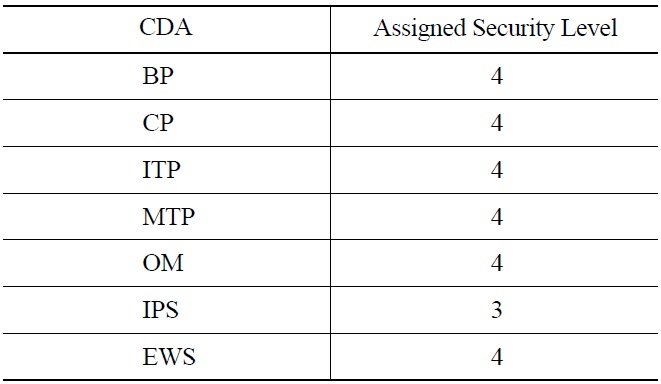
Security Levels Assigned to the PPS Components
of them and corresponding task procedures should be reviewed.
In Fig. 3, for the sample PPS, safety grade PLCs such as BP, CP, and ITP are at the highest security level., Based on the assumption in this study that the safety PLCs are not infected during manufacturing and delivering phases, only one track path from the outside can be expected through the EWS being connected to the PLCs during the maintenance and tests of them,. Since the EWS communicates with each of the PLCs, the EWS can be an entry point of cyber attacks. If the EWS accept the use of external media such as USB flash drives, the external media can become additional attack entry points. Therefore, it is evident that an attack vector to a PLC can be formed through the EWS.
At least two types of cyber attacks can be anticipated here. One affects a PLC directly causing it to malfunction, another installs malware into a PLC to expand infections to other CDAs in the system. The latter is much more elaborate, and may affect not only the infected CDA but also the whole system. Additionally, it can be anticipated from Fig. 3 that some manipulated information from the EWS can be transmitted to the BP and other PLCs or the MTP, and at last to IPS through the information networks. Information on the IPS will be displayed to the operators in the main control room so that they may judge the plant state incorrectly.
Based on this discussion of potential malicious attacks, the following major attack entry points, providing a path to attack vectors, can be identified in general I&C systems:
? Network: Malware or malicious activities can be expanded to CDAs through networks;
? User: Users may access CDAs for operation, maintenance, and tests. Since users can conduct malicious activities directly to CDAs, suitable security controls for their access, authentication, and accountability will be necessary;
? External Device: The external devices or systems used for the maintenance and tests are subjects for the analysis. The external devices connected to CDAs can modify or delete the programs residing in the CDAs. Since external devices, for example, laptops for the maintenance of I&C system are portable in general, they should be treated as critical elements providing attack vectors; and
? External Media: External media are the elements that can be connected to CDAs directly or indirectly through external devices. External media are able to access to industrial PCs or other computing devices to transfer and execute malicious code to modify system software or cause the systems malfunction. They can also be used to modify or delete the installed programs, or install abormal code. According to the capability to read and write, external media are categorized into read and write media, such as USB flash drives and hard disk drives, and read-only media, such as compact discs and DVDs.
In accordance with these elements of attack entry points, the following attack vectors affecing a target CDA can be defined;
■ Other CDAs to CDA: This implies that other CDAs connected to a target CDA and infected by malware or affected by malicious activities can expand the infection or malicious activities to the target CDA;
■ User to CDA: A hacker can access and attack a target CDA directly;
■ External Device to CDA: An external device is connected to a target CDA, and hence it can infect malware or conduct malicious activities to the CDA;
■ External Media to CDA: External media can access a target CDA, and hence they can infect malware or conduct malicious activities to the CDA;
■ User to CDA through External Device: A hacker can conduct cyber attacks to a target CDA by accessing an external device; and
■ External Media to CDA through External Device: A hacker could use external media to attack a target CDA through an external device to which the external media are connected.
Fig. 4 shows the elements of attack vectors discussed here.
2.1.5 Investigation of known Vulnerabilties and Penetration Tests
Based on the analysis of attack vectors, a vulnerability analysis and penetration tests are performed to identify the malicious activities that can compromise the target system. To identify the kind of cyber attacks that are possible for a target system, vulnerabilities for the CDAs composing a target system should first be investigated. Vulnerabilities already residing in systems can be exploited easily by hackers. Hence, it is important to investigate the known vulerabilities and determine their exploitability. Results from this analysis can be ascertained by performing penetration tests with a test-bed.
As noted in NIST 800-82 [22], there can be a potential for a disruption of the system when penetration tests are conducted. In this study, a test-bed consisting of one set of BP, CP, ITP, MTP, and OM is constructed for the penetration tests of the sample PPS. Analyses, based on this testbed, are performed with regard to what kinds of cyber attacks are possible and which measures can protect CDAs
against the attacks, by investigating the known vulnerabilities, the types of attacks exploiting the vulnerabilities, and their impact to the CDAs or on the system.
2.1.5.1 Analysis of known Vulnerabilities
The Common Vulnerability and Exposures (CVE) [23] are helpful in collecting the known vulnerabilities. The CVEcontains detailed information about the types of vulnerabilities, as well as the kinds of attack and loss types possible due to these vulnerabilities. It also provides web site information which is the source of detailed information. The information collected through the CVE, it is possible to analyze which systems may suffer from what kind of damages, and how high the risk will be. The information from this analysis is important to grasp the possibility of exploiting vulnerabilities and the level of resultant damages before the penetration tests.
Vulnerabilities for the operating system (OS), applications, and network of sample PPS were searched at the CVE, and those for only the OS were found. Table 3 presents the vulnerabilities searched for the OS in the test-bed for PPS and their impact. With the impact data in this table, it is possible to identify of the possible kinds of cyber attacks, in turn, this identification notifies the types of attacks that may be exercised during the penetration testings to verify the impact. In Table 3, “Local Exploit” in the column “Type” means that the attacks should take place at the installed location of PPS to compromise the system with those in “Impact.”
The results from these analyses may be used to define technical security measures to eliminate or restirict the known vulnerabilities. In relation to these measures, the
[Table 3.] Target System Vulnerabilities Searched from the CVE
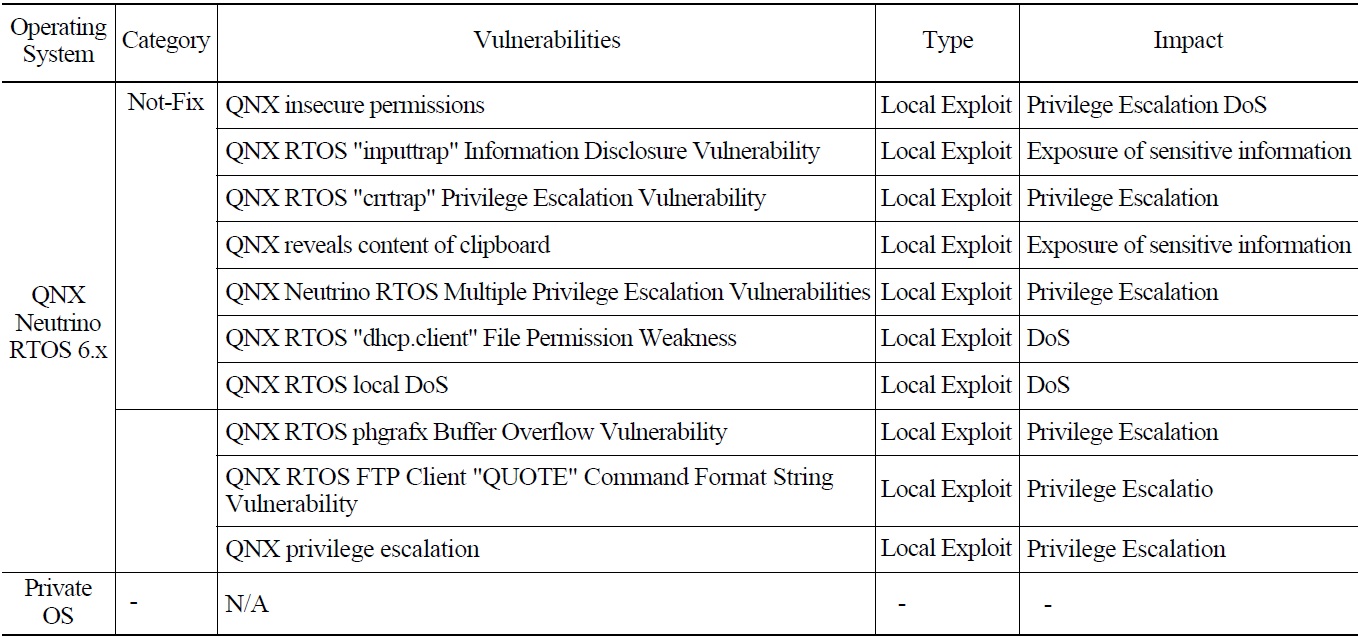
Target System Vulnerabilities Searched from the CVE
requirements in C.7 Defense-in-Depth of the RG 5.71, “devices are free from known malicious code,” and in C. 12.5 Developer Security Testing, “known insecure software components or libraries” should be considered.
2.1.5.2 Vulnerability Analysis of Maintenance Devices
It is also important to determine if the CDAs have the vulnerabilities exploitable by cyber attacks from the EWS, by identifying and analyzing local exploit vulnerabilities for attacking inside the system and their potential impact. It should be considered that a code for attacking inside the system from the EWS can be developed to exploit the known vulnerabilities of CDAs.
It is necessary to analyze the vulnerabilities of all digital assets that can affect the CDAs in the development environment as well as in a target system. Maintenance devices such as EWS are identified in section 2.1.4 as major attack entry points. During the development phase, the EWS is usually put in the same environment as the target system, and also has a possibility to be handled with less caution than the target system. It is important to identify and respond to potential threats from those devices. In detail, the possible threats and their effects from maintenance devices should be analyzed in consideration of the problems that may exist in those devices, such as ‘Insecure network /Internet access,’ ‘Insecure movable device use,’ and ‘Insecure configuration of System.’ Measures against cyber threats from the maintenance devices should be defined by performing the identification of types of threats to target CDAs, conditions enabling the threats and the consequences of the threats to take place,.
In this study for the sample PPS, it is assumed that the EWS for PPS PLCs is managed under a flexible security environment, and has the same configuration as general IT devices that may be connected intermittently to outside networks. Possible threats under the specific conditions of the EWS and their results are identified. Table 4 shows the results of this identification performed with the EWS for PPS PLCs.
An ‘Insecure network’ in this table can be treated with the requirements for B.1 Access Control, especially B.1.18 Insecure and Rogue Connections of RG 5.71 Appendix B, and ‘insecure movable device use’ with those in C.7 Defense-in-Depth and B.1.16 Open/Insecure Protocol Restrictions.
2.1.5.3 Analysis of Malicious Activities through Penetration Tests
Malicious activities that can take place in the CDAs and systems and their consequences can be evaluated in detail through penetration tests, which are performed on a test-bed based on the information from the analyses of attack vectors and vulnerabilities. Penetration tests, in this
[Table 4.] Vulnerability Assessment Results for the EWS
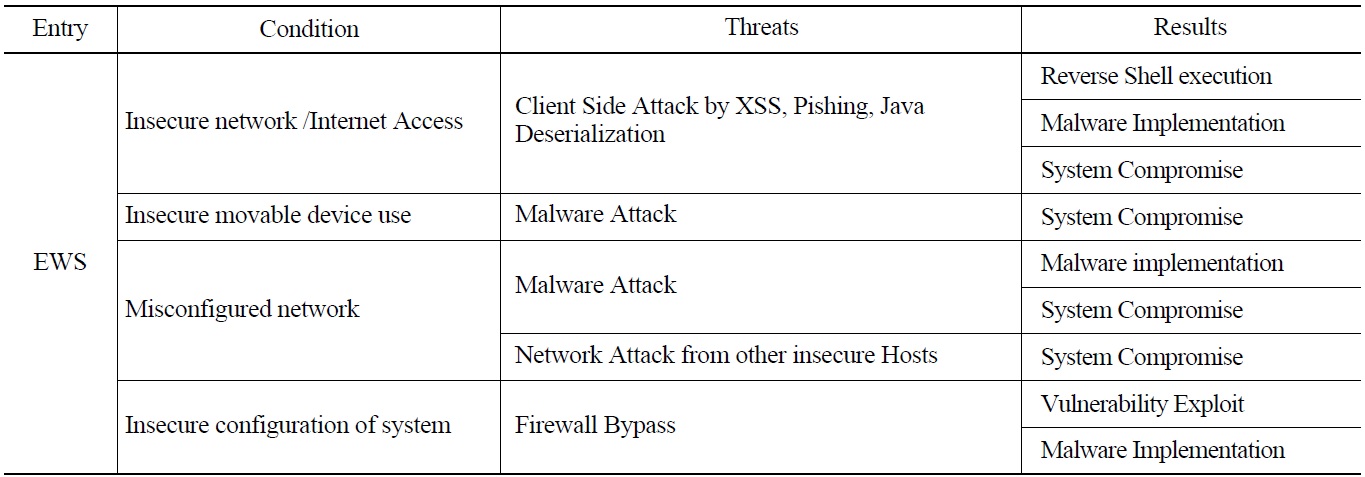
Vulnerability Assessment Results for the EWS
case, are to confirm the results from the previous analyses and verify the consequences of malicious activities. The results from these tests will help to define suitable security measures to protect the system from the malicious activities. Penetration tests can also be performed after the implementation of technical security controls into a target system to verify their effectiveness.
For the penetration tests with the test-bed, two attack vectors are defined, based on the discussion in section 2.1.4 and the vulnerability analyses in sections 2.1.5.2 and 2.1.5.3. Attack vector 1 starting from the EWS to a PLC and further to other CDAs in the system, and attack vector 2 from users to the MTP and to the sysem are defined. Fig. 5 shows these attack vectors in the test-bed. In the penetration tests, to identify malicious activities and their impact on the CDAs and throughout the whole system, conditions such as malware implementation, successful remote exploitation, and non-validated code execution are tested and possible malicious activities under these conditions are investigated.
As the results of penetration tests, Table 5 shows possible malicious activities and the conditions required for initiating the malicious activities. Security measures eliminating the conditions can be identified and applied in order for the corresponding malicious activities not to take place.
Technical security control requirements in accordance with the malicious activities identified in this way can be treated with the requirements in the RG 5.71. In detail, B.3.4 Denial of Service Protection for ‘DoS attack,’ B.5.2 Host Intrusion Detection System for ‘illegal task create,’ and B.1.4 Information Flow Enforcement for ‘packet modification’ should be considered.
2.2 Analysis of Technical Security Control Requirements in RG 5.71
The RG 5.71 contains a comprehensive set of security control requirements that should be applied to NPP I&C systems to protect them against cyber attacks. The RG 5.71 Appendix B contains°∞Technical Security Controls,” and Appendix C lists “Operational and Management Security Controls.” Appendix B lists requirements that are not considered as technical control requirements, and Appendix C includes some requirements that should be regarded as technical control requirements designed and implemented during the development of I&C systems. Therefore, it is necessary to review the requirements carefully for their applicability to the I&C systems.
2.2.1 Selection of Technical Control Requirements
Some parts of the technical security control requirements address security policy or procedures, which are not necessary for the design of security features to be implemented into the I&C systems. These will be excluded in this review. Also, the requirements that can be applicable to a general IT environment, but not appropriate to NPP I&C systems (e.g., Automated Marking), and those that are already incorporated
[Table 5.] Analysis of Malicious Activities of the Potential Attack Vectors
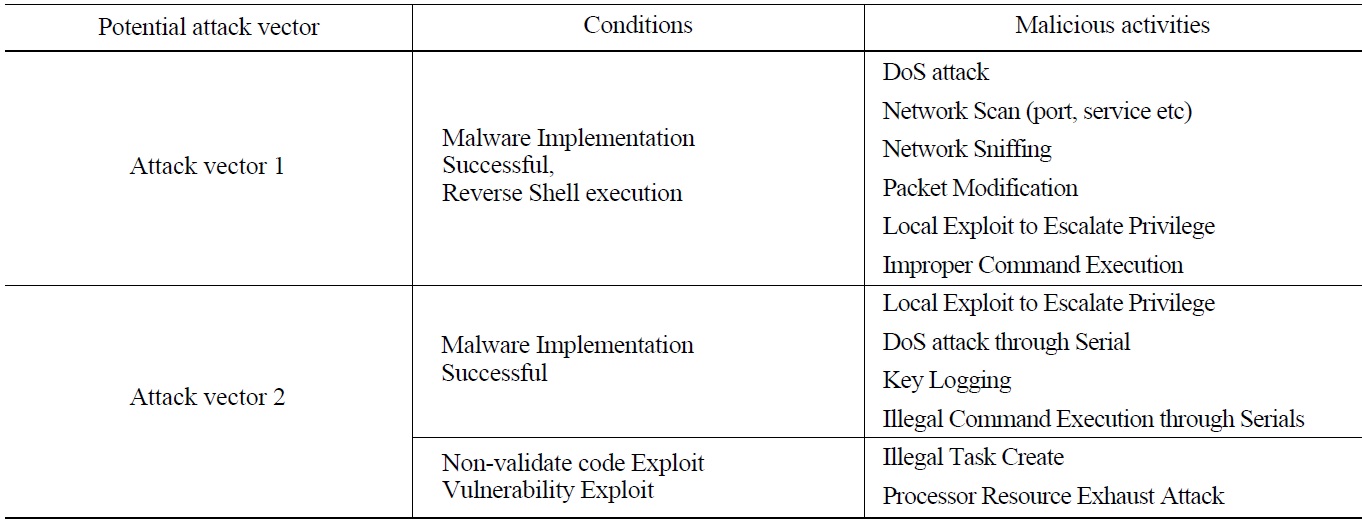
Analysis of Malicious Activities of the Potential Attack Vectors
into the I&C system design inherently as a part of development activities of safety systems, e.g., system verification and validation, can also be excluded. During this review, every sentence in the requirement descriptions should be evaluated, and in some cases, even a sentence may be separated into several items.
These criteria are also applicable when reviewing the requirements in Appendix C. There are requirements that can be regarded as technical security control requirements, for example, Malicious Code Protection, Monitoring Tools and Techniques, Information Input Restrictions, Maintenance Tools, Error Handling, Defense-in-Depth, Recovery and Reconstitution, Configuration Settings, Component Inventory, and Developer Security Testing.
Table 6 below lists examples that are excluded or limitted in its application for a review of the requirements in Appendix B, and table 7 presents example requirements in Appendix C which can be regarded as technical security control requirements.
2.2.2 Use of Vulnerability Analyses and Penetration Tests
The requirements selected as in the previous section should be evaluated individually for their applicability and effects on the target I&C systems. If all the requirements are incorporated into the systems, there must be adverse effects on the function or performance of systems. Also, individual technical security control requirements that are selected to achieve the security of a CDA may result in duplication for the same security purpose. There is a possiblity that the cost will increase enormously if security control requirements derived from service-oriented IT systems are applied to safety and reliability centered NPP I&C systems. For example, if security controls, such as a real-time access control for device-to-device identification, authentication, authorization, and data encryption, may be
[Table 6.] Example Requirements in Appendix B not Considered as Technical Control Requirements
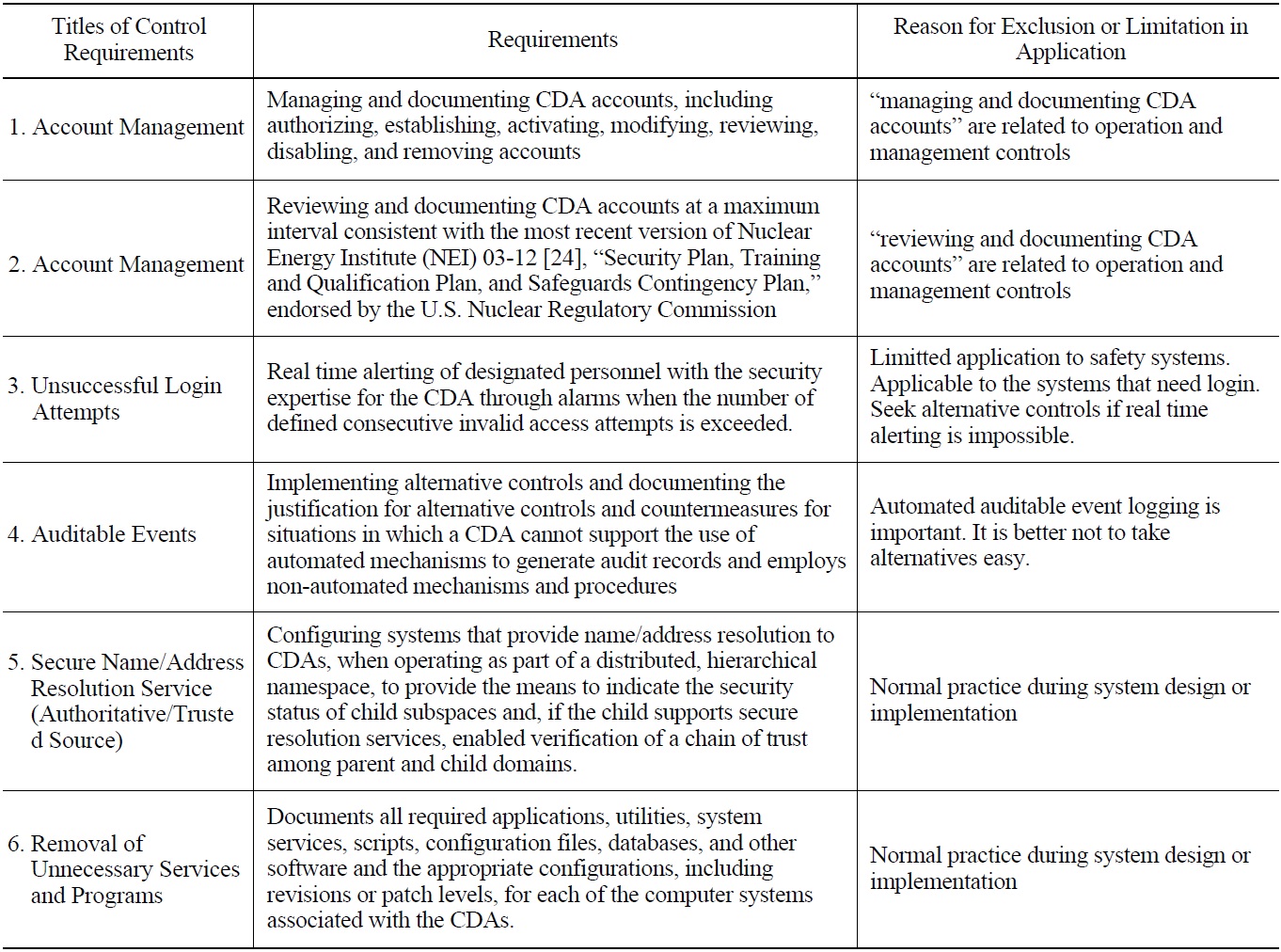
Example Requirements in Appendix B not Considered as Technical Control Requirements
[Table 7.] Example Requirements in Appendix C to be Treated as Technical Controls
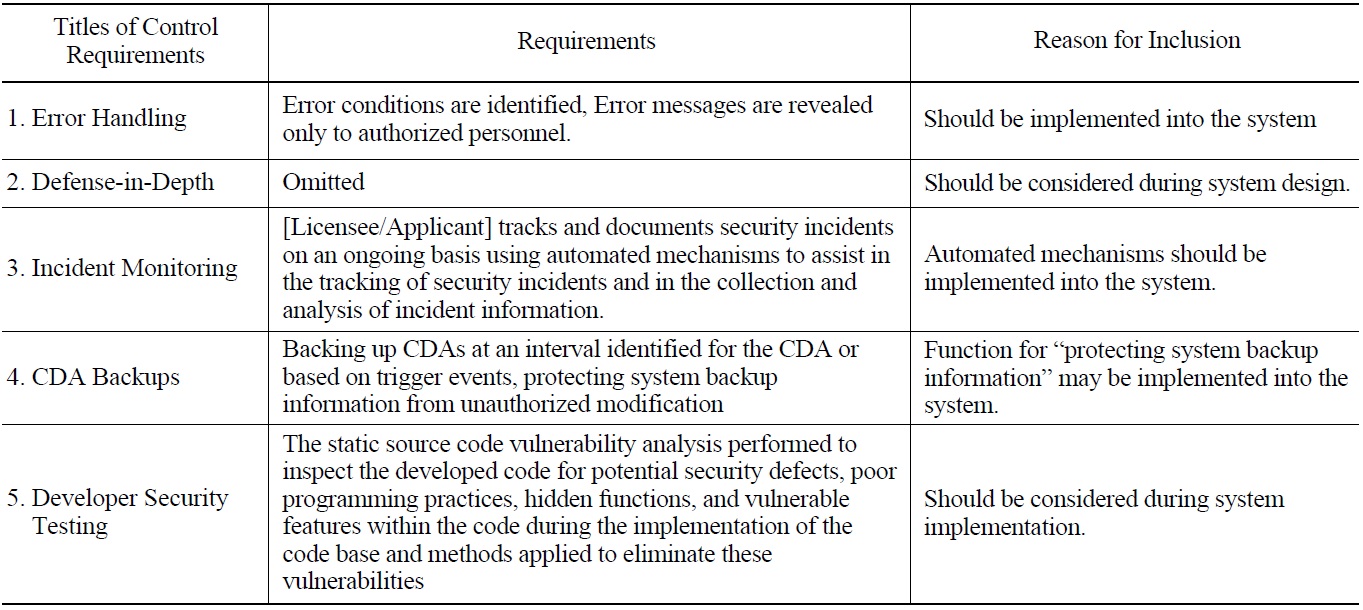
Example Requirements in Appendix C to be Treated as Technical Controls
applied to safety systems, it is evident that the availability of the systems will be adversely affected. As indicated in this argument, security controls should be applied to the systems with caution by analyzing if there are no adverse impacts during the implementation of the controls into the systems. There may be some limitations dependent on the target system when applying technical security control requirements. In cases of safety systems, which do not use general IT devices, the direct application of technical security controls to the CDAs will be very restricted. Critical security requirements with high priorities should be identified first through the vulnerability analyses and penetration tests, to assess the security requirements in a more objective way.
Security measures are identified to protect CDAs against the malicious activities resulting from the vulnerability analyses and penetration test in section 2.1.5. Table 8 shows these measures, and Fig. 6 shows the arrangement of these measures for the PPS security model.
As shown in Table 8 and Fig. 6 above, it is identified that access control, monitoring & logging, and encryption are the most critical technical security controls for the PPS. These security controls are general for safety systems, since the components and structures of the other safety systems are similar to the PPS, and can also be extended to non-safety systems because they have attack vectors similar to the PPS case.
? Access Control: For both safety and non-safety systems, identification and authentication, system and data restrictions, system use notification, domain, session, portable and mobile media, unauthorized access and use, communications access, etc.
? Monitoring & Logging: Monitoring and analyzing conditions for both safety and non-safety systems.
? Encryption: Network and data encrtyption mainly for non-safety systems.
Based on this argument, the requirements selected as
in section 2.2.1 can be classified into four groups including access control, monitoring and logging, encryption, and others. Table 9 lists the titles of the technical security control requirement in the RG 5.71 selected as in section 2.2.1 and classified in four groups.
To define applicable technical security requirements, attack vectors described in section 2.1 and technical requirements analysis in section 2.2 are integrated. Attack vectors in Fig. 4 need to be refined in more detail in accordance with the analysis of the requirements. Fig. 7 shows the results from this refinement. Among digital devices for the maintenance and tests, there can be non-authenticatable ones such as a digital tester. Although these devices do not have an authentication function, they may allow the use
[Table 8.] Security Measures Against the Malicious Activities Drawn in Section 2.1.5 for the PPS
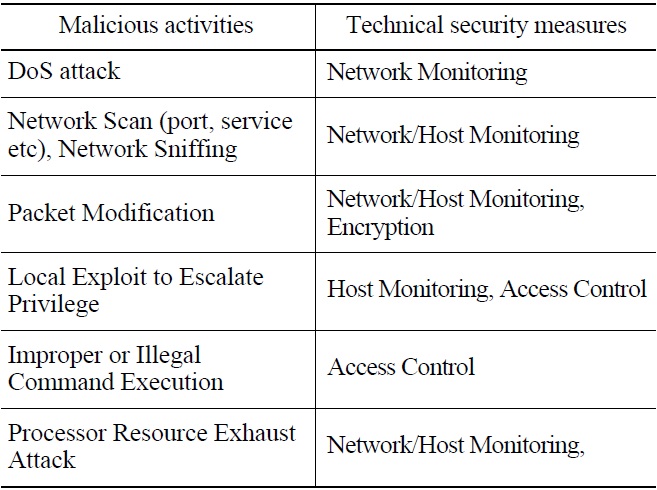
Security Measures Against the Malicious Activities Drawn in Section 2.1.5 for the PPS
of external media for data loading and backup purposes. Another point to consider in the identification of applicable requirements is that there are two different kinds of external media. A group of external media such as USB flash drives and HDDs has a read and write capability, and another group such as CD and DVD is read-only. According to this capability, applicable security requirements will be different from each other.
Where to apply the requirements grouped in Table 9 can be evaluated with the attack vectors in Fig. 7. The requirements are reviewed for the following elements:
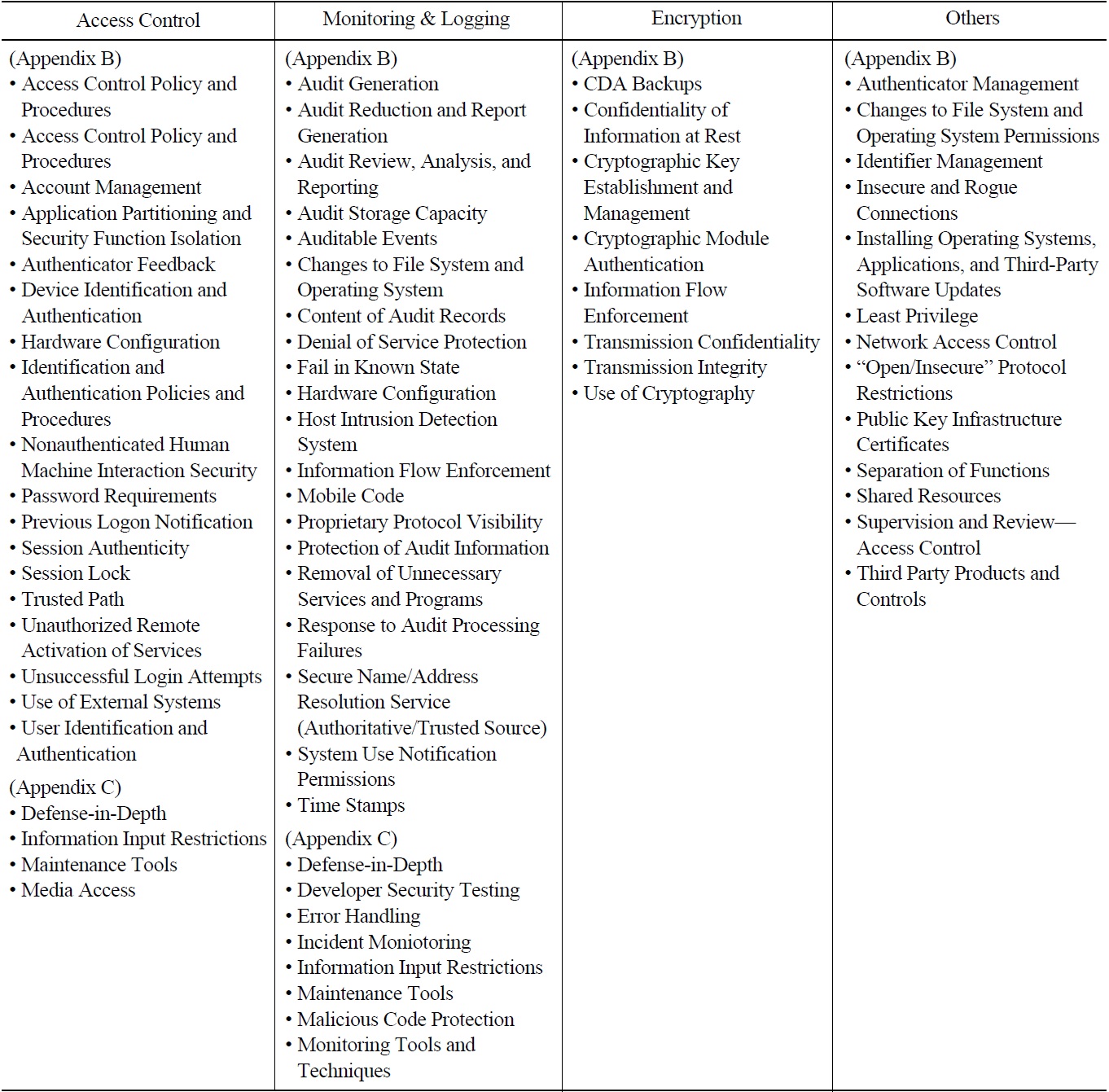
Titles of Technical Security Control Requirements Selected for the PPS and Classified in four Groups
? User to CDA: The requirements for access controls should be considered. Those for monitoring and logging may in part be applicable to the record information on users’ access to the CDA, if the CDA provides that logging function. Encryption requirements may be applied in part to a function handling user input for access controls. This can be dependent on the capability of CDA.
? External Devices (Authenticatable) to CDA : When external devices are connected to the CDA, the requirements of the access control should be considered. At least either the external devices or the CDA, which can process the authentication and recording the related information, should have security functions for access control and logging. The requirements for monitoring the data transmission along this path can be applied, if possible. Encryption of data transmitted between digital devices may not be necessary, if man-in-themiddle (MitM) attacks are not possible.
? External Media to the CDA: The requirements for access control should be considered, if external media may be connected to the CDA. The CDA should have functions of access control and real-time monitoring of data transmission, if this is not possible, the media record the history of access and data transmission. There can be access control provisions in both the media and the CDA. Encryption may not be needed here.
? External Media to External Device (Authenticatable): The requirements for access control and monitoring should be considered, at least for the items such as automated access control and management, monitoring, device identification, and error handling. Encryption may not be needed here.
? External Device (Non-Authenticatable) to CDA: In most cases, both devices cannot implement security functions, hence, device user, device identification, and related user tasks may be recorded manually. This is rather related to the security policy or management controls.
? External Media to External Devices (Non-Authenticatable): This may not be allowed in NPPs. But if any, operation and management controls similar to External Device (Non-Authenticatable) to CDA can be applied.
? Other CDAs to a target CDA: Data transfer between CDAs occur through networks. The newtwork architecture can be reviewed with the defense-in-depth requirements. Monitoring and logging for the data transmission should be considered. Access controls are very difficult to apply here, since there must be adverse impact to the function of CDAs. Encryption may bring similar impact, but for the non-safety systems, data storage servers and netwroks may consider the application of encryption.
? User to External Devices (Authenticatable): This can be treated similar to User to CDA. The requirements for access control and monitoring and logging should be considered in the external devices.
RG 5.71 requires that security controls should not cause any adverse impact on the safety function and performance of CDAs. If a security control requirement belongs to this category, alternative control requirements should be considered. For example in cases where, it may not be easy to implement real-time authentication functions for safetygrade PLCs. There are many cases addressing both basic requirements for technical security controls and alternatives in RG 5.71. In these cases, the alternatives address physical and/or management control requirements in general, and the basic requirements for technical security controls will be better than the alternatives for the security purpose. The alternatives may be considered, only if a specific security control requirement cannot be implemented because of the adverse impact.
The main purpose of encryption is to protect CDAs against man-in-the-middle (MitM) attacks. This may not be an effective form of control for safety systems, since MitM attacks are hard to expect in the environment where the safety systems are placed. The non-safety systems, which have computer systems and networks similar to industrial control systems or general IT systems, may consider the application of encryption for the confidentiality and integrity of the data stored and transmitted within the non-safety systems.
Security control devices for monitoring and logging are not currently avaliable in the nuclear domain. Hostbased intrusion detection systems (HIDS) required in RG 5.71 may cause an adverse impact on the system function. In this case, HIDS specially developed for NPP I&C systems not affecting system function or network-based intrusion detection systems (NIDS) can be candidates for monitoring and logging. All the IDS in local CDAs or networks may be integrated to provide plant-wide security monitoring, logging, and alarming services. This addition of security control devices will be followed by additional cyber security risk assessments. They will be treated as separate systems located in the same defensive architecture of the I&C systems with suitably assigned security levels. They may need to apply security control requirements such as those for access controls and encryption.
Based on the above discussion, technical control requirements are collected for the sample PPS., Table 10 shows the list of technical security control requirements for the sample PPS, collected from the classified RG 5.71 requirements in Table 9, according to the refined attack vector analysis in Fig. 7. If the configuration of other safety I&C systems in NPPs is considered, this table can be applied extensively to the safety systems. Table 10 also includes the technical security control requirements that should be addressed commonly in the design and development of I&C systems. Fig. 8 shows the application of technical security control requirements to the sample PPS.
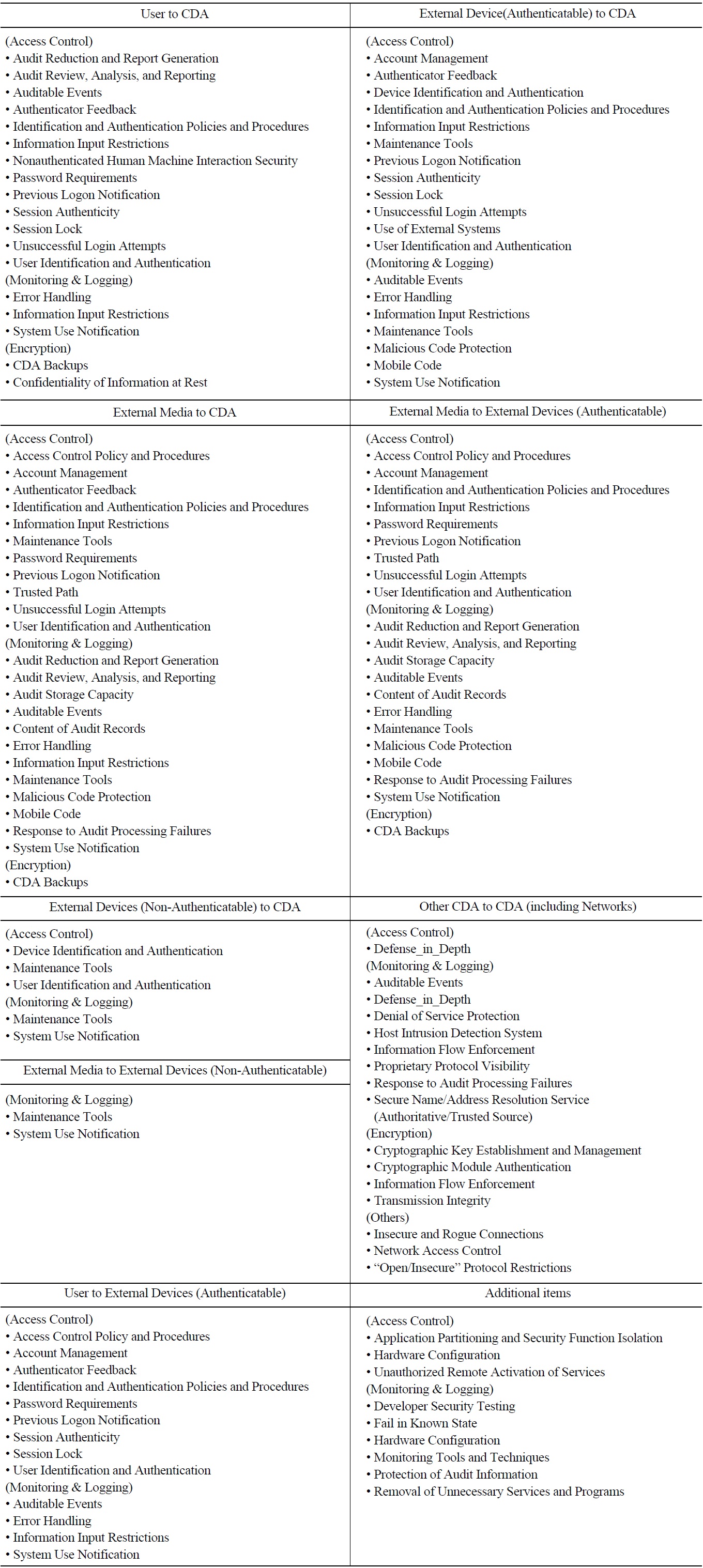
Technical Security Control Requirements for the Sample PPS Identified with the Elements of Refined Attack Vectors
Due to the digitalization of NPP I&C systems, cyber security has become an important issue. The RG 5.71 published by the U.S. NRC provides guidance for the cyber security of I&C systems, including cyber security plans and programs, methods for cyber security assessments, and a comprehensive set of security controls. There are still difficulties, from the system designer’s point of view, when trying to apply the requirements to target systems.
In order to provide helpful information for system designers in the application of cyber security requirements to systems, this paper describes methods and considerations to define attack vectors in a target system, to review and select the requirements in RG 5.71, and to integrate the results from these activities to identify applicable technical security controls according to the attack vectors.
The attack vector analyses are performed in a process consisting of the following activities: 1) Analysis of an I&C system architecture at the highest conceptual level; 2) Modeling of a target system in cyber security point of view; 3) Security level assignments to the CDAs of a target system; 4) Analysis of the elements of attack vectors; 5) Investigation of the known vulnerabilities residing in the CDAs and penetration tests to identify potential malicious activities.
The RG 5.71 provides the most complete set of requirements for the cyber security of NPP I&C systems. Among the security control requirements listed in Appendices B and C of RG 5.71, those that should be implemented into the systems are selected and classified in groups of technical security control requirements using the results from the attack vector analyses. For the attack vector elements of CDAs, all the requirements in the groups of technical security controls are evaluated in their applicability and effectiveness, and considerations in this evaluation are also discussed.
The methods proposed in this paper are practiced with a sample PPS system, and the technical security control requirements grouped according to the elements of attack vectors are presented as a result.
In conclusion, the proposed methods provide useful and practical information for NPP I&C system designers for the identification of appropriate technical security controls and their locations in the systems. Further studies are needed to search detailed practices of those control requirements, and to develop security devices and technologies best fitted to NPP I&C systems.
![Conceptual Data Flow Architecture of NPP I&C
Systems (Redrawn from Ref. [16])](http://oak.go.kr/repository/journal/12707/OJRHBJ_2013_v45n5_637_f001.jpg)
